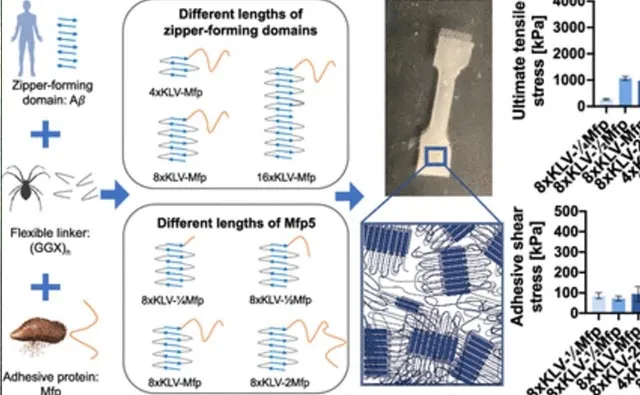Industry News, Adhesives & Sealants & Tackifiers
Researchers Engineer Customizable Bio-Adhesive for Personalized Medical Repair

Industry News, Adhesives & Sealants & Tackifiers

Traditional medical adhesives used in surgical applications often have limited bio-absorbability, high toxicity, and a lack of customizability, leading to suboptimal surgical outcomes. Recent advances in synthetic biology offer an alternative — tailored biocompatible and biodegradable adhesives designed for specific internal biomedical applications, such as in tissue repair and for surgical glues.
Researchers working with Fuzhong Zhang, professor of Energy, Environmental and Chemical Engineering in the McKelvey School of Engineering at Washington University in St. Louis, are tackling this challenge with a new class of hydrogels constructed entirely from proteins. Zhang’s collaborators include Marcus Foston, associate professor of Energy, Environmental and Chemical Engineering; Guy Genin, the Harold and Kathleen Faught professor of Mechanical Engineering; and Mohamed A. Zayed, associate professor of Surgery and Radiology. Their programmable design allows precise control over mechanical and adhesive properties, addressing the limitations of synthetic bio-glues. The research was published December 1, 2023, in ACS Applied Materials & Interfaces.
“This work is one of the first to prove that synthetic biology can be used not only to produce materials but also to understand material sequence-structure-function relationships,” said Juya Jeon, a graduate student in Zhang’s lab and first author of the study. “Our hydrogels are made of artificially designed proteins that have never been created before. These unique proteins give our hydrogels a combination of advantageous properties, including outstanding mechanical and underwater adhesive properties while being bio-absorbable and uniquely fitted to tissue repair/engineering applications.”
The team’s new material builds on previous studies from Zhang’s lab on underwater adhesives inspired by aquatic mussels and their sticky mussel foot proteins (Mfp). Jeon improved on the earlier work by carefully combining silk-amyloid peptides and Mfp into a silk-amyloid-mussel foot protein (SAM) hydrogel. Acting as a kind of molecular chef, Jeon adjusted the proportions of the two main ingredients to achieve SAM hydrogels that can be finely tuned to display unique combinations of biocompatibility, bio-absorbability, strength, stretchability, and underwater adhesion to biological surfaces.
They found that an increase in silk-amyloid repeats significantly enhanced cohesive strength and toughness, while extending Mfp length increased surface adhesion but decreased overall strength. One variant of particular interest demonstrated exceptional strength, strain resistance and underwater adhesivity when tested on a preclinical model.
“The sequence-structure-property relationships uncovered in this study provide invaluable insights to guide the future design of protein adhesives with tunable properties, paving the way for customized adhesives tailored to specific applications,” said Zhang. “This study marks a significant leap forward in the pursuit of safer, more effective surgical adhesives, opening doors to a new era of personalized bio-glues for diverse medical needs. It also illustrates how synthetic biology can be used to illuminate complex molecular relationships and manufacture advanced biomaterials.”
Juya Jeon, Kok Zhi Lee, Xiaolu Zhang, John Jaeger, Eugene Kim, Jingyao Li, Larisa Belaygorod, Batool Arif, Guy M. Genin, Marcus B. Foston, Mohamed A. Zayed, and Fuzhong Zhang*
Silk-amyloid-mussel foot protein (SAM) hydrogels made from recombinant fusion proteins containing β-amyloid peptide, spider silk domain, and mussel foot protein (Mfp) are attractive bioadhesives as they display a unique combination of tunability, biocompatibility, bioabsorbability, strong cohesion, and underwater adhesion to a wide range of biological surfaces. To design tunable SAM hydrogels for tailored surgical repair applications, an understanding of the relationships between protein sequence and hydrogel properties is imperative. Here, we fabricated SAM hydrogels using fusion proteins of varying lengths of silk-amyloid repeats and Mfps to characterize their structure and properties. We found that increasing silk-amyloid repeats enhanced the hydrogel’s β-sheet content (r = 0.74), leading to higher cohesive strength and toughness. Additionally, increasing the Mfp length beyond the half-length of the full Mfp sequence (1/2 Mfp) decreased the β-sheet content (r = −0.47), but increased hydrogel surface adhesion. Among different variants, the hydrogel made of 16xKLV-2Mfp displayed a high ultimate strength of 3.0 ± 0.3 MPa, an ultimate strain of 664 ± 119%, and an attractive underwater adhesivity of 416 ± 20 kPa to porcine skin. Collectively, the sequence-structure–property relationships learned from this study will be useful to guide the design of future protein adhesives with tunable characteristics for tailored surgical applications.
underwater adhesive, bioadhesive, protein materials, programmable material properties, amyloid beta-peptides, mussel foot protein, synthetic biology